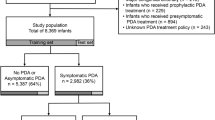Abstract
To use unsupervised machine learning to identify potential subphenotypes of preterm infants with patent ductus arteriosus (PDA). The study was conducted retrospectively at a neonatal intensive care unit in Brazil. Patients with a gestational age < 28 weeks who had undergone at least one echocardiogram within the first two weeks of life and had PDA size > 1.5 or LA/AO ratio > 1.5 were included. Agglomerative hierarchical clustering on principal components was used to divide the data into different clusters based on common characteristics. Two distinct subphenotypes of preterm infants with hemodynamically significant PDA were identified: “inflamed,” characterized by high leukocyte, neutrophil, and neutrophil-to-lymphocyte ratio, and “respiratory acidosis,” characterized by low pH and high pCO2 levels.
Conclusions: This study suggests that there may be two distinct subphenotypes of preterm infants with hemodynamically significant PDA: “inflamed” and “respiratory acidosis.” By dividing the population into different subgroups based on common characteristics, it is possible to get a more nuanced understanding of the effectiveness of PDA interventions.
What is Known: • Treatment of PDA in preterm infants has been controversial. • Stratification of preterm infants with PDA into subgroups is important in order to determine the best treatment. | |
What is New: • Unsupervised machine learning was used to identify two subphenotypes of preterm infants with hemodynamically significant PDA. • The ‘inflamed’ cluster was characterized by higher values of leukocyte, neutrophil, and neutrophil-to-lymphocyte ratio. The ‘respiratory acidosis’ cluster was characterized by lower pH values and higher pCO2 values. |


Similar content being viewed by others
Availability of data and materials
Data code is available at: https://github.com/fymatsushita/PDA.
References
Hamrick SEG, Sallmon H, Rose AT et al (2020) Patent ductus arteriosus of the preterm infant. Pediatrics 146(5). https://doi.org/10.1542/peds.2020-1209
Parkerson S, Philip R, Talati A, Sathanandam S (2021) Management of patent ductus arteriosus in premature infants in 2020. Front Pediatr 8(February):1–11. https://doi.org/10.3389/fped.2020.590578
Wilson JG, Calfee CS (2020) ARDS subphenotypes: understanding a heterogeneous syndrome. Crit Care 24(102):1–8. https://doi.org/10.1186/s13054-020-2778-x
Matsushita FY, Krebs VLJ, de Carvalho WB (2021) Identifying clinical phenotypes in extremely low birth weight infants—an unsupervised machine learning approach. Eur J Pediatr (0123456789). https://doi.org/10.1007/s00431-021-04298-3
Alloghani M, Al-Jumeily D, Mustafina J, Hussain A, Aljaaf AJ (2020) A systematic review on supervised and unsupervised machine learning algorithms for data science. https://doi.org/10.1007/978-3-030-22475-2_1
Terrin G, Di Chiara M, Boscarino G et al (2020) Echocardiography-guided management of preterms with patent ductus arteriosus influences the outcome: a cohort study. Front Pediatr 8(December):1–9. https://doi.org/10.3389/fped.2020.582735
Papile LA, Burstein J, Burstein R, Koffler H (1978) Incidence and evolution of subependymal and intraventricular hemorrhage: a study of infants with birth weights less than 1,500 gm. J Pediatr 92(4):529–534. https://doi.org/10.1016/S0022-3476(78)80282-0
Fenton TR, Kim JH (2013) A systematic review and meta-analysis to revise the Fenton growth chart for preterm infants. BMC Pediatr 13(1). https://doi.org/10.1186/1471-2431-13-59
Singh P (2019) Unsupervised machine learning. https://doi.org/10.1007/978-1-4842-4961-1_7
Ahsan M, Mahmud M, Saha P, Gupta K, Siddique Z (2021) Effect of data scaling methods on machine learning algorithms and model performance. Technologies 9(3):52. https://doi.org/10.3390/technologies9030052
Gewers FL, Ferreira GR, De Arruda HF et al (2021) Principal component analysis: a natural approach to data exploration. ACM Comput Surv 54(4). https://doi.org/10.1145/3447755
Sasirekha K, Baby P (2013) Agglomerative hierarchical clustering algorithm- a review. Int J Sci Res Publ 3(3):2–4.
Massey FJ (1951) The Kolmogorov-Smirnov test for goodness of fit. J Am Stat Assoc 46(253):68. https://doi.org/10.2307/2280095
Varoquaux G, Buitinck L, Louppe G, Grisel O, Pedregosa F, Mueller A (2015) Scikit-learn: machine learning without learning the machinery. GetMobile Mob Comput Commun 19(1):29–33. https://doi.org/10.1145/2786984.2786995
Hundscheid T, Onland W, Kooi EMW et al (2022) Expectant management or early ibuprofen for patent ductus arteriosus. N Engl J Med. https://doi.org/10.1056/NEJMoa2207418
Santa Cruz R, Villarejo F, Irrazabal C, Ciapponi A (2021) High versus low positive end-expiratory pressure (PEEP) levels for mechanically ventilated adult patients with acute lung injury and acute respiratory distress syndrome. Cochrane Database Syst Rev 2021(3). https://doi.org/10.1002/14651858.CD009098.pub3
Maddali MV, Churpek M, Pham T et al (2022) Validation and utility of ARDS subphenotypes identified by machine-learning models using clinical data: an observational, multicohort, retrospective analysis. Lancet Respir Med 10(4):367–377. https://doi.org/10.1016/S2213-2600(21)00461-6
Reddy K, Sinha P, O’Kane CM, Gordon AC, Calfee CS, McAuley DF (2020) Subphenotypes in critical care: translation into clinical practice. Lancet Respir Med 8(6):631–643. https://doi.org/10.1016/S2213-2600(20)30124-7
Author information
Authors and Affiliations
Contributions
Dr. Matsushita conceptualized and designed the study, drafted the initial manuscript, conducted all analyses, and reviewed the manuscript. Dr. Krebs conceptualized and designed the study and reviewed the manuscript. Dr. de Carvalho conceptualized and designed the study and reviewed the manuscript. All authors approved the final manuscript as submitted.
Corresponding author
Ethics declarations
Ethics approval
The study protocol was reviewed and approved by the institutional ethics committee (Comite de Ética do Hospital das Clínicas da Faculdade de Medicina da Universidade de São Paulo, CAAE 15762719.6.0000.0068) and informed consent was waived.
Competing interests
The authors declare no competing interests.
Additional information
Communicated by Daniele De Luca
Publisher's Note
Springer Nature remains neutral with regard to jurisdictional claims in published maps and institutional affiliations.
Supplementary Information
Below is the link to the electronic supplementary material.
Rights and permissions
Springer Nature or its licensor (e.g. a society or other partner) holds exclusive rights to this article under a publishing agreement with the author(s) or other rightsholder(s); author self-archiving of the accepted manuscript version of this article is solely governed by the terms of such publishing agreement and applicable law.
About this article
Cite this article
Matsushita, F.Y., Krebs, V.L.J. & de Carvalho, W.B. Identifying two distinct subphenotypes of patent ductus arteriosus in preterm infants using machine learning. Eur J Pediatr 182, 2173–2179 (2023). https://doi.org/10.1007/s00431-023-04882-9
Received:
Revised:
Accepted:
Published:
Issue Date:
DOI: https://doi.org/10.1007/s00431-023-04882-9




